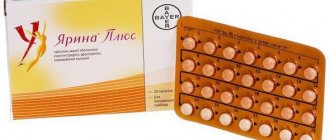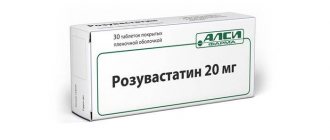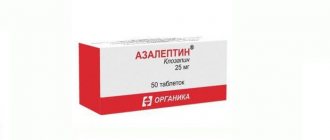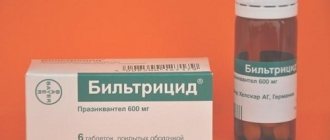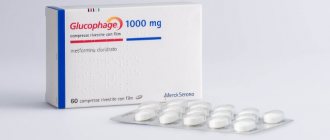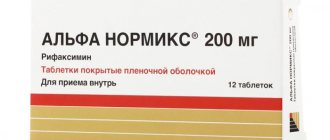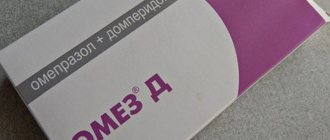Nitroxoline tablets
This medicine belongs to the group of non-fluorinated quinolones (synthetic antimicrobial drugs that have a bactericidal effect), and therefore belongs to the antibacterial agents derived from 8-hydroxyquinoline. However, Nitroxoline is not an antibiotic. The differences between these two groups of drugs are in the way they act on microorganisms. The fact is that antibiotics act more radically, sweeping away bacteria beneficial to humans along with pathogenic microflora along their path. Nitroxoline has a detrimental effect only on “bad” microorganisms.
Composition and release form
This drug is produced by pharmaceutical companies in only one form - tablets. For a more detailed description of Nitroxoline tablets, see the table below:
| Release form | Tablets for oral use |
| Tablet form | Biconvex |
| Shell color | Yellow to bright orange |
| Active substance | Nitroxoline |
| Dose of active substance in one tablet | 50 mg |
| Excipients | Lactose, corn and potato starch, sugar, talc, calcium stearate, aerosil titanium dioxide, food gelatin, povidone-25, magnesium carbonate, tropeolin O, macrogol 6000, dye, beeswax |
Pharmacodynamics and pharmacokinetics
Nitroxoline has an antimicrobial effect by blocking the synthesis of bacterial DNA. It forms compounds with enzymes, due to which there is a detrimental effect on the pathogenic microflora of the genitourinary system. Effective against a number of microorganisms: Staphyllococcus, Streptococcus, Mycobacterium Tuberculosis, Enterococcus, Salmonella, Klebsiella, Shigella, Escherichia Coli, Enterobacter, Trichomonas Vaginalis, etc. Active against fungi of the genus Candida, mold, dermatophytes, and some pathogens of deep mycoses.
After oral administration, the tablets are quickly absorbed from the gastrointestinal tract. The maximum concentration of the drug in the blood plasma is achieved 1.5 hours after use. The drug is excreted primarily by the kidneys, and unchanged, so high concentrations of the active substance are formed in the urine. The half-life of these tablets is approximately 2 hours.
What are Nitroxoline tablets for?
The drug is prescribed for the treatment of acute infectious processes and chronic infections of the genitourinary organs, which are caused by microorganisms sensitive to the active substance. To prevent infections, it is used during surgical interventions and instrumental manipulations (cystoscopy, catheterization, etc.). Often prescribed to prevent recurrent urinary tract infections. If a doctor has prescribed Nitroxoline, the instructions for use will tell you whether it is indicated for a specific disease. Indications:
- pyelonephritis (kidney inflammation);
- cystitis (inflammation of the bladder walls);
- urethritis (inflammation of the urinary tract);
- epididymitis (inflammation of the testicle in men);
- infection of a prostate tumor (adenoma or carcinoma).
Composition and release form
The drug is sold in tablet form. The main active ingredient is nitroxoline. One tablet contains 50 mg of the active ingredient. The product is positioned as an antimicrobial product for systemic use. General category - antibacterial pharmacological substances.
Pharmacological qualities
Nitroxoline is a uroantiseptic of synthetic origin. The mechanism of action is chelation. Influences the pathogen through three effects:
- bacteriostatic;
- bactericidal;
- fungicidal.
The drug is prescribed to combat infections caused by gram-positive, gram-negative bacteria and fungal agents. The maximum degree of effectiveness is achieved in the presence of the following microorganisms in the foci: Escherichia coli, Ureaplasmaurealyticum, Mycoplasmahominis, Candidaspp.
The tablets partially inhibit the pathological activity of Proteus, Corynebacteriumdiphteriae, Enterococcus spp and staphylococci.
The active substance is quickly absorbed. The peak concentration is recorded 2 hours after taking the tablet drug. The antimicrobial component is metabolized in the liver and excreted through the urinary tract with urine (partially with bile).
Indications for use of an antimicrobial agent
Nitroxoline tablets help against urinary tract pathologies. The medicine helps eliminate the source of inflammation and the source of the pathogen. The drug is recommended to be taken for the following diseases:
- infected adenoma;
- pyelonephritis;
- cystitis;
- prostate carcinoma, aggravated by inflammatory or infectious processes;
- urethritis;
- epididymitis.
An antimicrobial agent can completely replace an antibiotic when organizing preventive measures in the postoperative period. This is relevant specifically when performing surgical interventions on the genitourinary organs, in various pathological conditions of the kidneys. The product can be used for a similar purpose after catheterization and during cystoscopy.
How to drink Nitroxoline
Nitroxoline kidney tablets, following the instructions, should be taken orally after meals, swallowed whole and washed down with a small amount of water. They can be treated continuously for a month, if complete recovery according to laboratory tests does not occur earlier. Dosage:
- The usual daily dose of the drug for adults is 400 mg, divided equally into 4 doses, that is, 2 tablets 4 times a day.
- For severe infections, the doctor may increase the daily dose to a maximum of 800 mg or 4 doses of 4 tablets.
- In the case of chronic cystitis or pyelonephritis, the usual dosage of the medicine is prescribed, but it is not used constantly, but in courses - 2-3 weeks of administration alternated with two-week breaks for several months, but not more than six months.
- For preventive purposes during surgical manipulations of the genitourinary system, the drug is taken from 14 to 21 days, 2 tablets 4 times a day.
Instructions for use
It is recommended to take tablets during meals or immediately after meals. Adult men and women need to take 100 mg of the drug 4 times a day.
The pediatrician calculates the dosage for children individually.
Complex urological diseases require increasing the single dose to 200 mg. The frequency of administration per day is 4 times.
How much antimicrobial medication to take is decided solely by the doctor who is treating the patient and developing the dosage. The average duration of the course of therapeutic influence is from 2 to 3 weeks. Treatment with repetition of basic courses several times in a row with a break of 14 days is acceptable.
[media=
https://youtu.be/SF5yIISAXhs
]
special instructions
Nitroxoline, as a rule, is well tolerated if you strictly follow the prescribed dosage and do not combine the use of these tablets with other undesirable drugs. As for the reception features, the following points should be taken into account:
- People with renal failure need to use the tablets very carefully to avoid cumulation (accumulation) of the drug.
- During treatment, the color of the urine may become bright yellow.
- It is not recommended to drink alcohol together with Nitroxoline, so as not to burden the liver.
- Long-term use of the drug stimulates the development of optic neuritis, so the course of treatment should be determined strictly by a doctor.
Nitroxoline during pregnancy
The instructions for the drug indicate that these tablets are contraindicated during pregnancy and lactation, but in practice this medicine is often prescribed to both expectant and young mothers. It’s just that no studies have been conducted on the toxicity of Nitroxoline for the fetus, so manufacturers in this way insure themselves against possible troubles. Since the middle of the last century, gynecologists around the world, if necessary, have been treating pregnant women in the second and early third trimester for genitourinary infections with Nitroxoline tablets, because during this period their effect on the fetus is minimal.
Features of application
Treatment of urological diseases with Nitroxoline tablets should not last more than 4 weeks. The drug contains a specific dye. In some cases, allergic reactions to this particular component of the tablets are possible.
The risk is noted in patients who suffer from atypical sensitivity to acetylsalicylic acid.
The tablets contain lactose. For this reason, the drug is not prescribed to people with the following pathological abnormalities:
- hereditary galactose intolerance;
- glucose-galactose malabsorption syndrome;
- lactase deficiency.
It is worth notifying your doctor in advance if there are problems of this kind. The tablets contain sucrase; patients with diabetes are forced to refuse the medicine. It is not recommended to drink alcohol while taking the drug.
Nitroxoline for children
This drug is completely excreted by the kidneys unchanged, without harming the liver in any way, therefore it is approved in pediatric practice. Under the supervision of a doctor, the medicine is prescribed to infants from the age of three months, if the disease is caused by microorganisms sensitive to the drug. Since it is only available in tablet form, the instructions indicate how to use the tablets for children from three years of age. Dosage of Nitroxoline for children: 200-400 mg of the drug per day, depending on the age and body weight of the child.
- Pickled cucumbers with citric acid
- Gluten - what it is and why it is harmful. List of foods that contain gluten
- How to weave figures from rubber bands on a machine and without it. Weaving figures from rubber bands, video
Indications for use
Indications for Nitroxoline according to the instructions are the following conditions:
- Diseases of the genitourinary tract of an infectious-inflammatory nature (cystitis, pyelonephritis, carcinoma or infected prostate adenoma, etc.) caused by microorganisms sensitive to Nitroxoline;
- Prevention of infections during therapeutic and diagnostic procedures (cystoscopy, catheterization), as well as in the postoperative period after surgical interventions on the genitourinary tract and kidneys.
For impaired renal and liver function
Although these tablets are often prescribed for the complex treatment of kidney diseases, people with kidney or liver failure should take the drug very carefully and only after consulting with their doctor. Patients with moderate renal or hepatic impairment are usually prescribed half the usual dose. For people with severe forms of the above diseases, the drug is strictly contraindicated.
Drug interactions
Before you start taking this drug, you need to remember that not all other medications can be used with it. For example, when taken simultaneously with tetracycline antibiotics or Nystatin, the effectiveness of both drugs increases, so it is advisable to reduce the dose of drugs by half during treatment. Nitroxoline should not be used in combination with nitrofurans, so as not to stimulate the appearance of a negative neurotropic effect. It is also worth separating the use of Nitroxoline and antacid stomach medications in time.
Rules for drug combinations
To enhance the pharmacological effect, Nitroxoline is combined with tetracycline antibiotics. The summation of effects is also relevant for the treatment of complex mixed infections. Nalidixic acid and hydroxides reduce the pharmacological potential of antimicrobial tablets.
Antacids, as well as pharmacological products containing magnesium, interfere with the absorption of the antimicrobial agent.
Nitrofurans are strictly prohibited from being introduced into a therapeutic regimen if Nitroxoline is already present in it. The reason is an increase in negative neutrotropic influence.
Side effects
If the dose of Nitroxoline to relieve the symptoms of the disease is selected correctly by the doctor, the patient should not have any side effects from taking the drug. However, sometimes during use, unpleasant side reactions may appear for various reasons:
- nausea;
- vomit;
- headache;
- dizziness;
- tachycardia;
- loss of appetite;
- impaired coordination of movements;
- allergic reactions;
- liver dysfunction;
- paresthesia (feeling of “goosebumps” on the skin).
Side effects
Given the specific mechanism of action of the antimicrobial agent, as well as the duration of therapy, Nitroxoline may cause side effects. The main negative manifestations during antimicrobial therapy:
- anorexia;
- obsessive nausea;
- severe vomiting;
- skin rashes;
- polyneuropathy;
- cephalalgia of varying degrees of intensity;
- disturbances in liver function;
- itching;
- paresthesia;
- peripheral neuritis;
- tachycardia;
- ataxia.
If a whole set of complications develops, the course is interrupted. The doctor, analyzing the situation, makes a decision regarding further tactics for managing the patient.
Overdose
Nausea, vomiting, general weakness, severe tachycardia - such symptoms in combination often indicate an overdose. As a rule, the accumulation of drugs does not lead to death, but can have a very negative impact on health, especially in patients with serious chronic diseases or cancer. In addition, long-term use of the drug can cause optic neuritis. In case of an overdose of tablets, the following measures are urgently taken:
- gastric lavage;
- temporary withdrawal of the drug;
- taking enterosorbents and other medications to relieve symptoms of poisoning.
Directions for use and dosage
According to the instructions, Nitroxoline is prescribed to adults in a dosage of 600-800 mg per day, divided into 3-4 doses. The interval between doses of the drug should not be less than 6-8 hours. The duration of treatment is two weeks. The maximum dosage per day is 1-1.2 g.
The dosage of Nitroxoline for children is 10-30 mg/kg of body weight, divided into 3-4 doses.
For constantly recurrent and chronic infections, the duration of treatment can reach several months.
According to the instructions, Nitroxoline is taken an hour before meals with a full glass of water. It is necessary to strictly follow the treatment regimen for indications for Nitroxoline, and do not skip taking the medication. If, however, a tablet was missed, it is necessary to take it as quickly as possible, and if it is already time to take the next tablet, then the dose should not be doubled.
If during treatment with Nitroxoline there is no improvement within several days, you should consult a doctor about discontinuing the drug.
Contraindications
Like any drug, Nitroxoline - according to the instructions for use - is strictly contraindicated for a number of diseases. You should not take these tablets if:
- severe chronic renal failure;
- severe liver damage;
- hypersensitivity to quinoline drugs;
- cataracts;
- polyneuritis;
- neuritis of various etiologies;
- deficiency of the enzyme glucose-6-phosphate dehydrogenase;
- individual intolerance to the components of the drug.
In what cases should you not take Nitroxoline?
This drug has a fairly strong effect on the kidneys and liver. Therefore, any functional ailments of these organs make it impossible to take Nitroxoline.
It should not be taken if:
- renal failure;
- liver failure;
- cataract:
- diseases of the nervous system;
- during pregnancy or breastfeeding.
Also, you should not use this remedy in case of general weakening of the body under the influence of other diseases or drugs.
How to take the medicine?
Nitroxoline tablets should be taken orally during and after meals after reading the instructions for use.
For adults, the maximum permissible dose of the drug per day
is
0.8 g . But this measure is used for the most severe complications and forms of the disease.
The standard dose for adults is 0.4 g . It is recommended to take four times a day, therefore, divide the dose into four parts.
This medicine can be taken for 2-3 weeks . But depending on the severity of the disease, a longer course of treatment is possible.
In case of a chronic form of the disease of the urinary system, the course can be repeated with a break of at least 14 days .
After various operations on the canals of the genitourinary system, the doctor may prescribe Nitroxoline for prevention .
The duration of the preventive course is the same as during treatment, and the dose is reduced to 0.1 g per day.
There is no information about any precautions in the use of the medicine by drivers or employees during the performance of work duties.
Compliance with the treatment regimen prescribed by the doctor during the course of taking the medicine will help him most effectively influence the source of the disease.
Do not skip doses. The medicine must be taken at a certain time , maintaining an equal interval between doses.
Under no circumstances should you double the dose .
If there are no trends towards improvement and recovery, you should consult your doctor.
During the course, the tongue may have a reddish-yellow tint. Urine can also be colored this color.
Analogs
The name of this drug completely coincides with the name of the active substance. However, there are synonymous drugs, the name of which is slightly different, but their composition is almost identical:
- 5-Nok;
- Nitroxoline-forte;
- 5-Nitrox;
- Nitroxoline-UBF;
- Nibinol;
- Nikiol;
- Nitroxoline-Acos;
- Niuron;
- Nixibiol;
- Uroxoline;
- Uritrol.
Pharmaceutical companies also produce analogues of the drug, which contain other active substances, but have the same antimicrobial effect:
- Amizolide;
- Dioxin;
- Zanex;
- Kubitsin;
- Monural;
- Sangviritrin;
- Fosfomycin;
- Linezolid-Teva et al.
Nitroxoline price
The cost of the tablet drug varies, it depends on the manufacturer, the difference is noticeable. It is believed that the more expensive the drug, the better it is, but in practice this is not so - the composition and quality are almost identical:
| Number of tablets per package | Manufacturer | Price in rubles |
| 50 | Irbit chemical plant | 88 |
| 50 | Anzhero-Sudzhensky Chemical Plant | 112 |
| 50 | Tatkhimpharmaceuticals | 99 |
| 50 | Uralbiopharm | 104 |
| 50 | Irbitsky HFZ | 67 |
| 50 | Uralbiopharm | 61 |
| 50 | Biosynthesis | 72 |
| 50 | Technologist | 62,13 |
| 50 | Borshchagovsky Chemical Plant | 63,31 |

